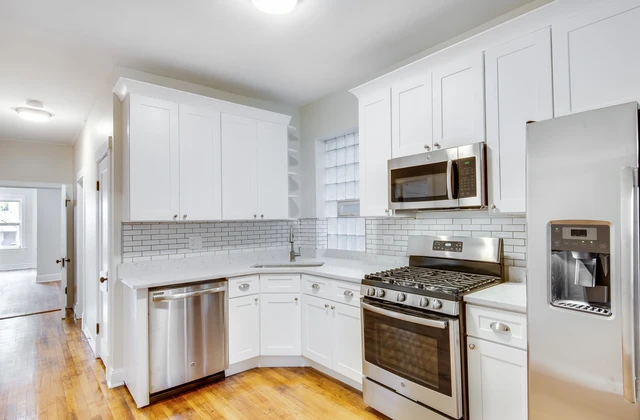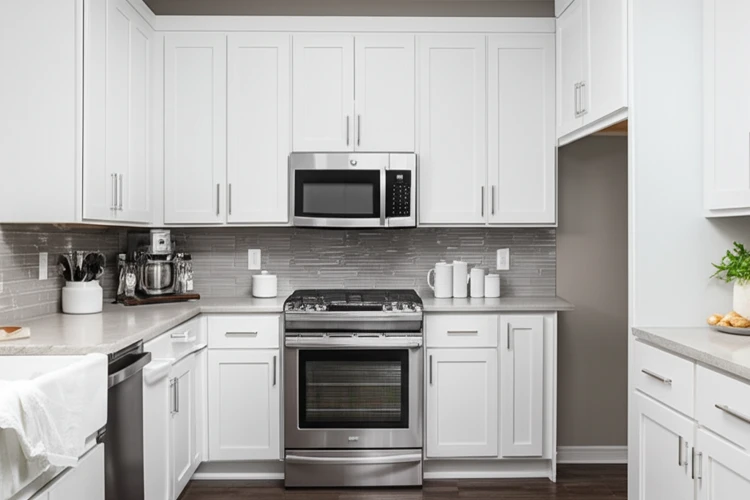Disclaimer: As an Amazon Associate, I earn commission from qualifying purchases.
The appeal of a white kitchen with stainless steel appliances has grown significantly over the years, with homeowners and renters alike embracing this timeless combination. According to a recent survey by the National Kitchen and Bath Association, white kitchens remain the top choice for 67% of homeowners due to their clean, modern look and versatility. Stainless steel appliances complement this aesthetic perfectly, offering durability, ease of cleaning, and a sleek, contemporary appeal.
A white kitchen with stainless steel appliances is not just about aesthetics; it also offers functional benefits. Stainless steel is renowned for its durability and resistance to corrosion, making it a long-lasting choice for appliances. Additionally, its non-porous surface makes it easy to clean, which is essential in a kitchen environment. Industry publications such as House Beautiful and Better Homes & Gardens often highlight the modern appeal of stainless steel, noting its ability to blend seamlessly with various design styles.
However, maintaining the shine and functionality of stainless steel requires regular upkeep. Manufacturers like Bosch and Samsung provide detailed guidelines on cleaning and maintaining their appliances, ensuring they remain in optimal condition. Transparent information on longevity and maintenance is crucial for homeowners to make informed decisions.
Key Elements of a White Kitchen Design
Designing a white kitchen involves several key elements that contribute to its overall appeal and functionality. Cabinetry, countertops, and backsplashes are fundamental components that can significantly impact the look and feel of the space.
Cabinetry in a white kitchen often features clean lines and a smooth finish, enhancing the room’s bright and airy feel. Shaker-style cabinets are a popular choice due to their timeless design and versatility. Countertops in materials like quartz or marble add a touch of elegance and durability. For backsplashes, subway tiles or glass mosaics can create a visually appealing and easy-to-clean surface.
Well-known interior design blogs and magazines, such as Houzz and Architectural Digest, frequently showcase white kitchen designs that incorporate these elements. They provide balanced perspectives on different design choices, helping homeowners make informed decisions. Design principles like symmetry, balance, and the use of natural light are often emphasized to create a harmonious and inviting space.
Choosing the Right Stainless Steel Appliances
Selecting the best stainless steel appliances for a white kitchen involves considering various factors, including functionality, energy efficiency, and aesthetic compatibility. Refrigerators, ovens, and dishwashers are essential appliances that can significantly impact the kitchen’s overall efficiency and appeal.
When choosing a refrigerator, consider models with features like adjustable shelves, dual-zone temperature control, and energy-efficient settings. Ovens with convection cooking and self-cleaning capabilities can enhance cooking performance and reduce maintenance efforts. Dishwashers with multiple wash cycles and quiet operation are ideal for busy households.
Product reviews from reputable sources like Consumer Reports and CNET can provide valuable insights into the performance and reliability of different appliance models. Transparent pricing information and disclaimers about potential limitations are crucial for making informed purchasing decisions. For example, the Samsung Family Hub refrigerator offers innovative features like a built-in touchscreen and smart home integration, but it comes at a premium price.
Organizing Your White Kitchen with Stainless Steel Appliances
Efficient organization is key to maximizing the functionality of a white kitchen with stainless steel appliances. By following a step-by-step approach, homeowners can create a space that is both aesthetically pleasing and highly functional.
Start by assessing the available storage and identifying areas that can be optimized. Use organizational tools like shelf organizers, drawer dividers, and pull-out trays to maximize cabinet space. Professional organizers recommend zoning the kitchen into specific areas for food preparation, cooking, and cleaning to improve workflow and efficiency.
Stainless steel appliances can also contribute to better organization. Refrigerators with adjustable shelves and door bins allow for flexible storage solutions. Ovens with built-in racks and dishwashers with adjustable tines can accommodate various dish sizes and types. Practical, actionable tips from professional organizers can help homeowners make the most of their kitchen space.
Maintaining Your Stainless Steel Appliances
To keep stainless steel appliances looking new and functioning well, regular maintenance is essential. Understanding the proper cleaning techniques and products can help extend the lifespan of these appliances and maintain their appearance.
Use specific cleaning products designed for stainless steel to avoid scratching or damaging the surface. Manufacturer guidelines and industry standards recommend using a mixture of mild dish soap and warm water for regular cleaning. For tougher stains, a solution of white vinegar and water can be effective. Always wipe in the direction of the grain to maintain the finish.
Balanced advice on different cleaning methods can help homeowners choose the best approach for their appliances. For example, while some may prefer using commercial stainless steel cleaners, others might opt for natural solutions like olive oil to restore shine. Addressing common misconceptions, such as the belief that stainless steel is completely stain-proof, can also provide valuable insights.
Sustainability in a White Kitchen with Stainless Steel Appliances
Incorporating sustainable practices and eco-friendly products into a white kitchen with stainless steel appliances can contribute to a more environmentally conscious lifestyle. Simple changes can make a significant impact on reducing waste and conserving resources.
Choose energy-efficient appliances with high Energy Star ratings to reduce energy consumption. Opt for reusable containers and eco-friendly cleaning products to minimize waste. Environmental studies and eco-friendly publications like TreeHugger and EcoWatch offer practical tips for reducing waste and conserving resources in the kitchen.
For example, installing a water-efficient faucet can help conserve water, while using energy-efficient light bulbs can reduce electricity usage. Sustainable products like bamboo cutting boards and silicone baking mats can replace less eco-friendly alternatives. By adopting these practices, homeowners can create a more sustainable and eco-friendly kitchen environment.
Energy Efficiency and White Kitchen Appliances
The energy efficiency of stainless steel appliances plays a crucial role in creating a more eco-friendly kitchen. Understanding how these appliances contribute to energy savings can help homeowners make informed decisions.
Energy Star guidelines and other official documentation provide valuable insights into the energy efficiency ratings of different appliances. For example, Energy Star-certified refrigerators can use up to 40% less energy than standard models. Similarly, Energy Star-certified dishwashers can save on both water and energy usage.
Transparent information on energy savings can help homeowners understand the long-term benefits of investing in energy-efficient appliances. For instance, while the initial cost of an Energy Star-certified appliance may be higher, the savings on energy bills over time can offset this cost. Additionally, many utility companies offer rebates for purchasing energy-efficient appliances, further incentivizing this choice.
Best Practices for Kitchen Efficiency
Improving kitchen efficiency involves adopting best practices that optimize workflow and task management. By implementing these strategies, homeowners can create a more functional and efficient kitchen space.
Professional chefs and kitchen planners recommend organizing the kitchen into zones based on specific tasks, such as food preparation, cooking, and cleaning. This approach helps streamline workflow and reduces the time spent moving between different areas. Using efficient storage solutions, such as pull-out trays and lazy Susans, can also enhance accessibility and organization.
Actionable tips and balanced advice from industry experts can provide valuable insights into improving kitchen efficiency. For example, installing a pot filler faucet near the stove can eliminate the need to carry heavy pots of water, while using a magnetic knife strip can save counter space and keep knives easily accessible.
Case Studies: Optimized White Kitchens
Analyzing case studies of optimized white kitchens with stainless steel appliances can provide real-world examples of how to improve efficiency, organization, and sustainability. These case studies highlight the design and organizational strategies used to create functional and aesthetically pleasing kitchens.
For instance, a case study of a kitchen remodel in a suburban home showcased the use of white Shaker-style cabinets, quartz countertops, and a subway tile backsplash to create a bright and inviting space. The integration of Energy Star-certified stainless steel appliances enhanced the kitchen’s energy efficiency and modern appeal. Professional kitchen designers emphasized the importance of strategic planning and attention to detail in achieving a well-optimized kitchen.
Another case study of a small urban apartment kitchen demonstrated how maximizing storage and utilizing multi-functional appliances could create a highly efficient and organized space. The use of pull-out trays, adjustable shelves, and a compact dishwasher helped optimize the limited space, while the stainless steel finish of the appliances added a sleek and modern touch.
Common Issues and Solutions
Homeowners often face common issues with white kitchens and stainless steel appliances. Addressing these challenges with expert-backed solutions can help maintain the kitchen’s functionality and appeal.
One common issue is the visibility of fingerprints on stainless steel surfaces. Using specific cleaning products designed to remove fingerprints and applying a thin layer of mineral oil can help maintain a smudge-free finish. Industry publications and professional advice recommend regular cleaning and polishing to keep appliances looking their best.
Another challenge is the potential for white kitchens to feel sterile or uninviting. Incorporating warm accents, such as wooden cutting boards, colorful textiles, and plants, can add warmth and personality to the space. Balanced advice and disclaimers about the limitations of white kitchens can help homeowners make informed design choices.
FAQs
How do I keep my stainless steel appliances fingerprint-free?
To keep stainless steel appliances fingerprint-free, use specific cleaning products designed for stainless steel. Apply a thin layer of mineral oil after cleaning to create a protective barrier that resists fingerprints. Regular wiping with a microfiber cloth can also help maintain a smudge-free surface.
What are the best cleaning products for stainless steel?
The best cleaning products for stainless steel include mild dish soap and warm water for regular cleaning, and a solution of white vinegar and water for tougher stains. Commercial stainless steel cleaners and polishes can also be effective, but always follow manufacturer guidelines to avoid damaging the surface.
How can I maximize storage in a small white kitchen?
To maximize storage in a small white kitchen, use organizational tools like shelf organizers, drawer dividers, and pull-out trays. Install wall-mounted shelves and utilize vertical space for additional storage. Opt for multi-functional appliances and consider open shelving to create the illusion of more space.
What are the most energy-efficient stainless steel appliances?
The most energy-efficient stainless steel appliances are those with high Energy Star ratings. Look for refrigerators with dual-zone temperature control and energy-efficient settings, ovens with convection cooking and self-cleaning capabilities, and dishwashers with multiple wash cycles and quiet operation.
How do I incorporate sustainable practices in my white kitchen?
To incorporate sustainable practices in your white kitchen, choose energy-efficient appliances, use reusable containers and eco-friendly cleaning products, and install water-efficient faucets. Opt for sustainable materials like bamboo and silicone, and consider composting food waste to reduce environmental impact.
Conclusion
Optimizing a white kitchen with stainless steel appliances involves a combination of aesthetic appeal, functional design, and sustainable practices. By choosing the right appliances, organizing efficiently, and maintaining proper upkeep, homeowners can create a kitchen that is not only beautiful but also highly functional and eco-friendly.
The key takeaways from this blog emphasize the importance of making informed decisions, adopting best practices, and incorporating expert-backed solutions to common kitchen challenges. By doing so, homeowners can enjoy a well-optimized kitchen that meets their needs and enhances their lifestyle.







